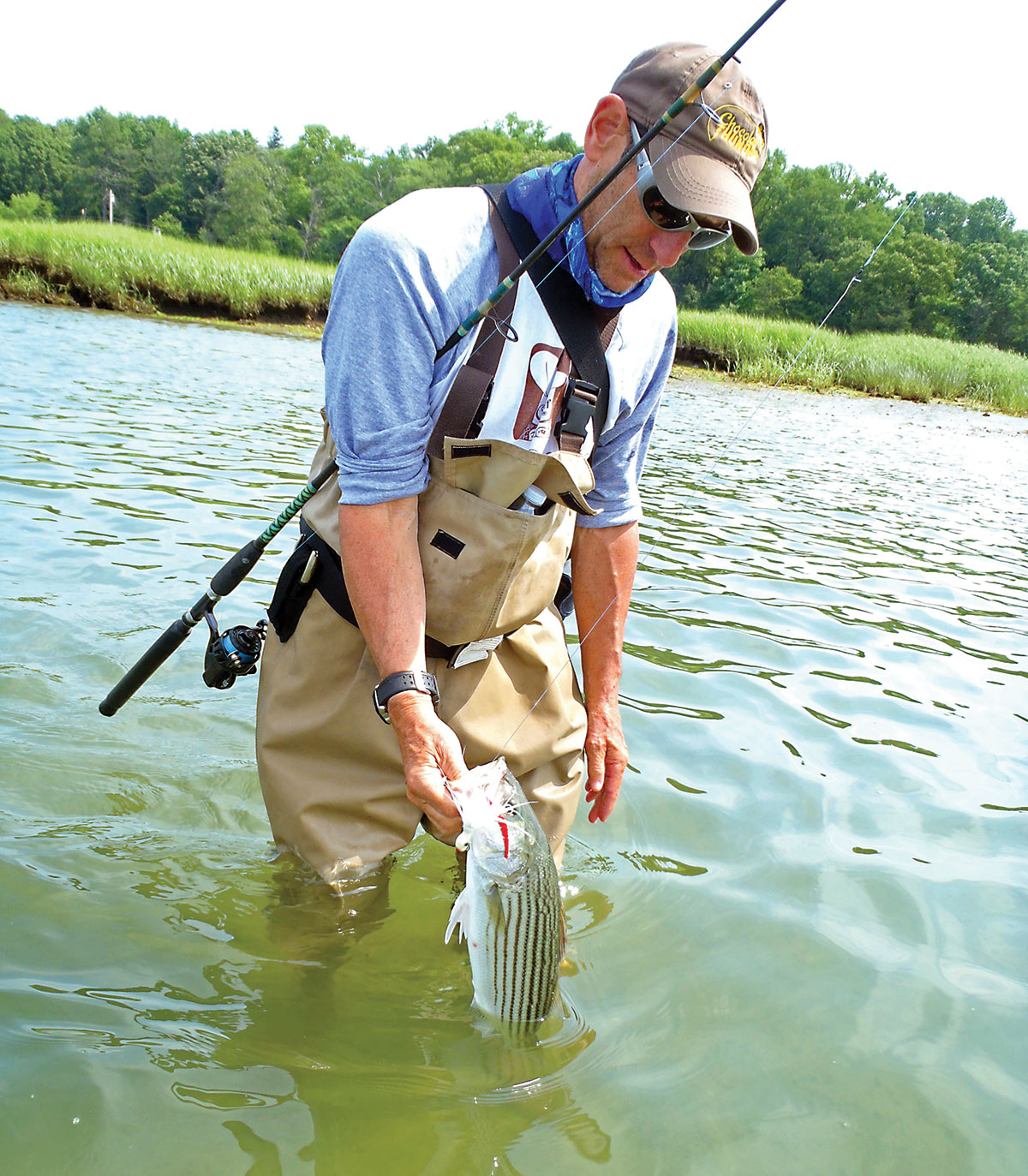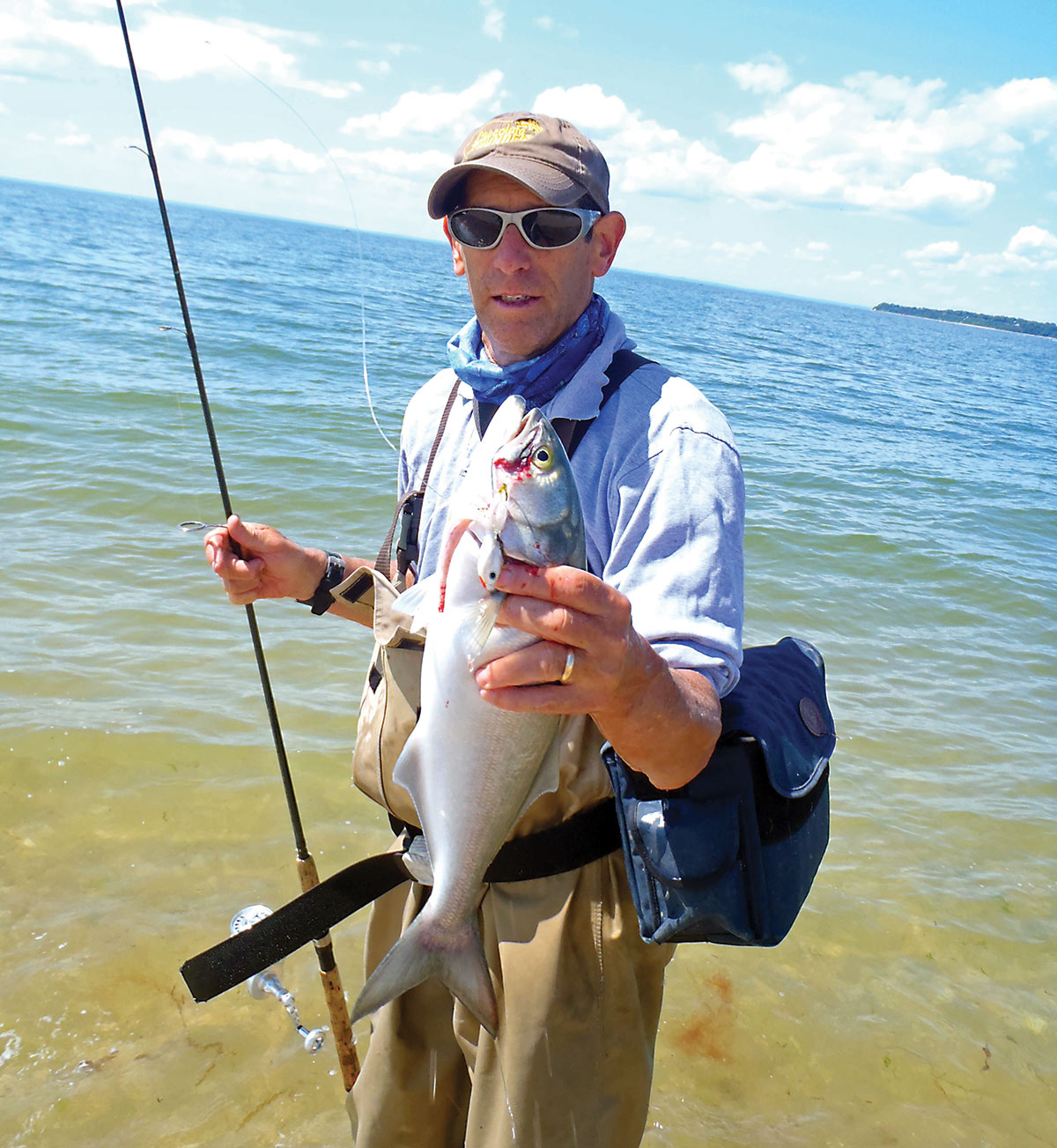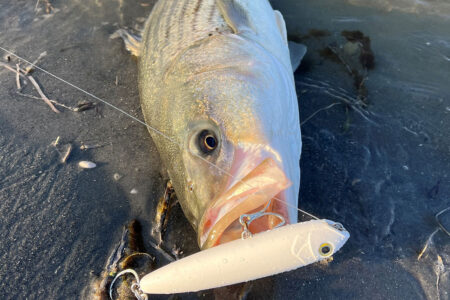
During the dog days of summer, stripers may be a bit reclusive, but schools of small blues are often ready to please.
After what, you ask? Well, after the May run of south shore blues, and after the May-June run of stripers on the north shore (we hope), what next? There are two ways to look at this problem. Some sharpies work late night tides in harbors searching for out-sized stripers that move in from daytime deep-water haunts in search of bunker and small porgies. This strategy requires patience and discipline as well as a commitment of hours. However, for many of us, the cost in lost sleep and family friction is too high. Instead, some anglers prefer to search the beaches mostly by day in search of whatever Mother Nature has decided to send our way, and most of the time that means small blues and stripers. In summer, stripers may be a bit reclusive, but schools of small blues frequently please.
Sand Eels
Many surf rats don’t appreciate how much a successful surf fishing season hinges on the size of the annual sand eel year class. In recent years, sand eel year classes have been poor to fair, and explains in part why north shore surf success has been limited. The abundance of sand eels, like so many fish species, is cyclical and we’ve been in a down part of the cycle since the early 2000s. Don’t confuse this with large adult ocean sand eels whose abundance is not only linked to the magnitude of annual year classes, but other factors, too. Perhaps I’ll discuss this in an ocean piece down the line, but for now let’s focus on the north shore.
The annual year class of sand eels sets up the entire year for surf fishermen in Long Island Sound. When 2- to 4-inch sand eels are abundant in the spring they draw in squid, fluke, stripers and blues and hold them until water temps warm in early July. At this point sand eels retreat into deeper parts of the Sound as well as out of the south shore bays and into the near ocean. However, if sand eels are not abundant by late May, only limited numbers of the above mentioned four marine critters will be present. The rest of the fish will leave prematurely in search of abundant food in the waters along the Rhode Island and Massachusetts coasts. The result is that large schools of stripers and blues will migrate through our waters quickly and go north, leaving only scattered groups of predators in our waters. This is precisely what happen in 2017, and accounts for why fishing along north shore beaches was spotty and catch numbers generally small for larger stripers and blues.
What happens when there’s lots of sand eels in spring? As I’ve already noted, sand eels hold large schools of stripers and blues in our shallow waters well into the summer. By the time the sand eels retreat to deeper water there are usually large schools of 3/4- and 1-inch peanut bunker. Therefore, the blues and bass can simply switch from one food to another and do not abandon the shallows to find food.
Good News
However, as long as there are some sand eels in the Sound a repeating pattern allows surf anglers along the north shore to enjoy bluefish; at least small blues, through July and sometimes into August. Usually, schools of small (1- to 3-pound) blues arrive sometime in June and begin attacking the sand eels. In years when sand eel schools are numerous and dense, raids of small blues along the beaches can occur, off and on, all day long. However, in lean sand eel years the blues typically appear more often at first light for about an hour and then at twilight.

These marauding blues aren’t found everywhere at the same time, but will appear more often where sand eel schools are consistently found. It helps if there’s at least some current, because it makes feeding easier. So, choose your favorite access point and look for rips over shell beds and sand bars, and currents at creek and river mouths as some of the best spots to find blues. However, it is also common for sand flats to come alive with blues during the last couple of hours of the ebb tide. You may need to wade out to them sometimes, but sand eels love sand flats where soft sand and some soil are mixed. That pretty much defines most sand flats in Long Island Sound from Little Neck Bay to Orient Point, so there’s no need for an angler to travel too far from home.
Obvious access begins at the State Parks such as Sunken Meadow and Wildwood, but town beaches provide good access, too. Nowadays, most towns issue parking stickers for their beaches that residents can purchase: another reason to stay close to home and learn how your backyard spots work.
Best Lures
There is a wide variety of lures that will catch roaming summer bluefish including surface lures. But I try to avoid treble hooks whenever I can, not only for my own safety, but also to make unhooking easier. Rest assured, that if watching surface explosions are your thing, small poppers and pencil poppers are productive. You aren’t likely to catch many stripers this way since bass tend to feed closer to the bottom in summer, but bluefish are bluefish and usually can’t resist a surface lure.
Yes, bucktails catch these blues, but it chafes me to ruin a bucktail on small blues. They chew on the hairs and macerate them, and the sharp points of their teeth cut the thread windings that hold the hair in place. Oddly enough, small blues often do more damage to bucktails than large ones. But, if I believe there are stripers or larger blues in the area, I’ll consider sacrificing a bucktail for the greater good. Along this same line of thought, I obviously avoid the use of soft plastic lures. Even if you own a mess of cheap ones, the time spent replacing plastics on hooks that are bitten in half or chewed into pieces takes away from catching bluefish, especially since there are a host of durable lures that catch bluefish just as well or better.
So, most of the time I use small “tins” or metal lures with or without small tubes. One of my favorite lures for these occasions are 1-ounce spoon jigs. These are curved metal lures with short thin tubes on the hook. I prefer dark red, black, chartreuse, and white tubes. Spoon jigs wiggle, and because of their shape, they ride higher in the water column. This is important because the most effective tides for summer small blues in Long Island Sound span the time between half-out and half-in. This means we are frequently fishing in only a few feet of water. Spoon jigs are available from many bait and tackle dealers including Terminal Tackle in Kings Park.
If you prefer more conventional “tins” you have a wide variety to choose from including, Fjord, Kastmaster, Hopkins, Ava, Luhr-Jensen, and West End Tackle models. I often use Ava 007 and 017 jigs (with and without short tubes on the hook) for distance, and the Luhr-Jensen Krocodile models in appropriate weights are effective, too.However, other than spoon jigs, my favorite metal lures are produced by West End Tackle because they are durable and have great action. Since the blues are usually small, I use the “J” models from J-1 to J-6. These range from 3/4 to 1-3/4ounces; the heavier models when more distance is needed.
Although the above-mentioned lures are all made of metal, they aren’t necessarily used the same way. Different brands feature various design profiles that affect not only sink rate but swimming action too. Ava jigs, for example, feature less surface areas than J model tins and so they sink faster, and are usually retrieved more quickly. On the other end of the design spectrum are spoon jigs whose large surface area, slim design and curved shape make the lure sink quite slowly and ride toward the water surface when retrieved. I can use the 1-ounce model in only 2 to 3 feet of water, retrieve at a moderate speed, and never drag bottom. These lures are designed to be retrieved just fast enough to remain a foot or so off the bottom and wobble slowly.
Tides & Tackle
In most places in Long Island Sound the last half of the out-going tide is the most reliable in summer. However, schools of small blues behave differently from their big brothers and sisters and certainly differently than stripers. Therefore, if a fishing spot is close to home I might check the spot out frequently rather than invest all my time on the last of the ebb. One thing to keep in mind when it comes to tides in late spring and summer is the affect wind can have on weed. At lower stages of the tide a northerly wind is more likely to rile the weed into the water column than at high water, often making fishing difficult or impossible. A south wind, on the other produces calm clear water.

Most of the fish caught will be small blues and scattered school stripers, but I feel it’s a mistake to go too light. For one thing, sometimes the blues cavort off the beach and longer casts are needed. Second, now and then a big blue may mix in, and since the Sound is loaded with rock piles, moorings and shell beds, a little extra beef helps the angler to land those unexpected bigger fish. For overall effectiveness and ease of casting, I go for a medium power fast tip 9-foot graphite rod, a VS 200, and 20-pound test Sufix Performance braid. I can cast far when I need to, muscle a bigger fish when I get lucky, and still get a nice rod bend from 2- to 4-pound blues. I always use a 30-pound test Perlon leader. I tie a 50-pound test swivel on one end that is then attached to the running line, and a 75-pound test Tactical Anglers paperclip style snap on the other end to attach the lure. The leader has several advantages. One, it prevents line twist. Two, it offers a little protection against bluefish teeth. Third, I can wrap the leader around my hand to help control the fish. Braid, on the other hand, is likely to cut through your skin.
I love fishing, plain and simple, so when there’s no big fish to catch during summer doldrums I look to put a bend in my rod. That could mean snapper fishing with small tins in order to enjoy a few tugs on ultra-light tackle, or 1- to 3-pound blues. Small choppers may not be on the top of my hit parade of fish, but they put a few bends in my rod when other species and bigger specimens have forsaken us. It’s all about having fun!




